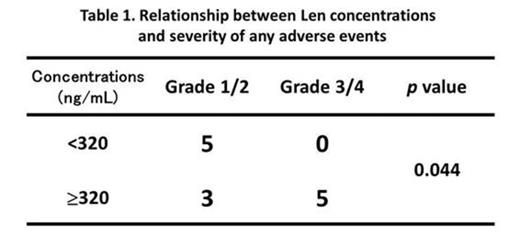Abstract
Lenalidomide (Len), an immunomodulatory drug, has significant clinical activity in patients with relapsed and refractory multiple myeloma (MM), and it is usually administered at a dose of 25 mg daily. For Len to exert its therapeutic effects with minimum adverse effects, it is important to determine the most suitable dosage on the basis of the physiques and body surface area (BSA) of patients. We investigated the relationship between pharmacokinetic variability of this drug and its toxicity and therapeutic efficacy. The institutional review boards and ethics committees at both participating centers approved the study protocol and all patients provided written informed consent. Thirteen Japanese patients with relapsed and refractory MM were enrolled in this study. They were treated with Len at 10-25 mg for 21 days every 4 weeks. The dose of Len administered to patients with renal dysfunction was reduced according to consensus statements on the optimal use of Len. Dexamethasone at 8-40 mg weekly was added to each drug cycle. Peripheral blood was collected three hours after Len administration in the first cycle and the plasma concentration of Len was evaluated using high performance liquid chromatography. Response and progression were assessed according to the International Myeloma Working Group criteria and the severity of adverse events was graded according to the Common Terminology Criteria for Adverse Events (CTCAE) Version 4.0. The median values of age (years) and estimated creatinine clearance (eCLcr, mL/min) of the 13 enrolled patients (male to female ratio=5:8) were 69 and 66.3, respectively. The number of patients in stages I, II, and III or the unknown stage of the International Staging System were 8, 1, 2, and 2, respectively. The number of the patients who achieved the best responses during three cycles of treatment were one (7.7%) in complete response, four (30.8%) in partial response, and eight (61.5%) in stable disease. The percentage of hematological adverse events (Grade 3/4) was 38.5% and no non-hematological events (Grade 3/4) were observed.
The Len concentration ranged from 172.5 ng/mL to 555.6 ng/mL with a median concentration of 341.8 ng/mL. eCLcr values did not correlate with Len concentrations, but significantly correlated with C/D ratios (p <0.005, Figure 1). We next evaluated the correlation between Len concentration and the severity of adverse events. The percentage of patients with any Grade 1/2 adverse event and the percentage of those with Grade 3/4 adverse events were 61.5% (8/13) and 38.5% (5/13), respectively. A Receiver Operating Characteristic curve analysis of Len concentrations was used to determine an optimal cutoff value with the Youden index. The percentage of severely of any Grade 3/4 adverse event for patients with ≥ 320 ng/mL Len was 62.5% (5/8), and that of patients with <320 ng/mL was zero (0/5). The Fisher's exact test demonstrated that the severity of adverse effects significantly correlated with the Len concentration (Table 1, p <0.05). However, there was no correlation between Len concentrations and best responses. These findings indicate that it is possible to avoid severe adverse events without reducing therapeutic efficacy by monitoring Len concentrations. In conclusion, this pilot study suggests that it is important to determine the Len dosage on the basis of its plasma concentration. This issue should be clarified further in a large-scale study.
Kado:Japan Community Health Care Organization Kyoto Kuramaguchi Medical Center: Employment. Kitazawa:Japan Community Health Care Organization Kyoto Kuramaguchi Medical Center: Employment. Fuchida:Japan Community Health Care Organization Kyoto Kuramaguchi Medical Center: Employment. Okano:Japan Community Health Care Organization Kyoto Kuramaguchi Medical Center: Employment. Hatsuse:Japan Community Health Care Organization Kyoto Kuramaguchi Medical Center: Employment. Murakami:Japan Community Health Care Organization Kyoto Kuramaguchi Medical Center: Employment. Ueda:Japan Community Health Care Organization Kyoto Kuramaguchi Medical Center: Employment. Kokufu:Japan Community Health Care Organization Kyoto Kuramaguchi Medical Center: Employment. Shimazaki:Japan Community Health Care Organization Kyoto Kuramaguchi Medical Center: Employment.
Author notes
Asterisk with author names denotes non-ASH members.



